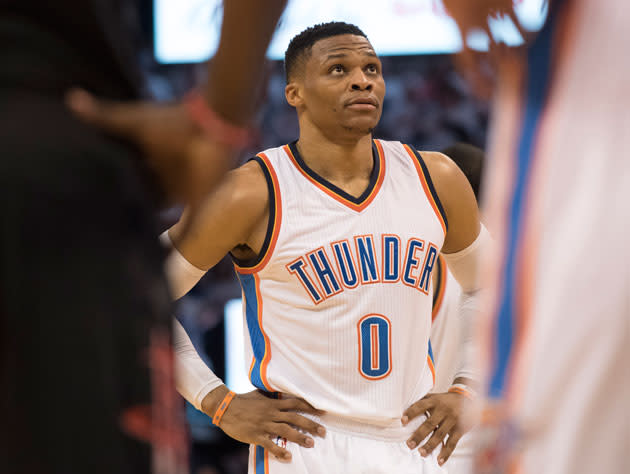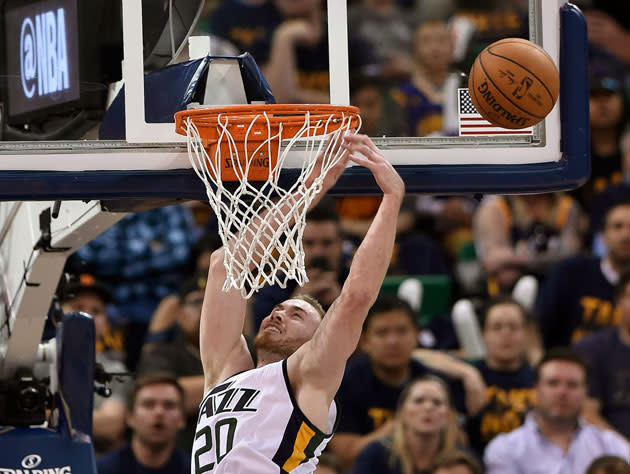The All-NBA Teams are out, and Paul George and Gordon Hayward can't be happy

The NBA released its All-NBA Teams on Thursday, and while the usual assortment of MVP-level good guys dot the rosters, much of the focus on the release surrounds the exclusion of Indiana Pacers four-time All-Star Paul George, and 2017 All-Star and Utah Jazz free agent-to-be Gordon Hayward.
[Follow Ball Don’t Lie on social media: Twitter | Instagram | Facebook | Tumblr]
Rather than merely triggering bonuses, or Wikipedia entry sidebar credits, All-NBA teams currently boast a feature that’s come under fire of late. Under the new collective bargaining agreement between the NBA and its players, inclusion on one of the three media-voted teams opens the door for All-NBA players to receive Designated Player status if the awardees are on their second contracts with their rookie teams. The status was designed to provide for greater financial incentive for young talent to with the incumbent teams, whether the ones that drafted them or the ones that traded for them while still on their rookie deals, even after great individual success.
In missing the squads, George won’t be eligible for a five-year extension with the Pacers, starting this summer, with his yearly salary equaling 35 percent of his team’s cap. The 2018 free agent could have signed a massive deal to stay in Indiana through 2023, and his All-NBA absence in spite of 23.7-point. 6.6-rebound averages and an All-Star appearance could cost him upward of $70 million, depending on how the final cap figures shake out.
With its hometown advantage reduced, Indiana might look to trade George rather than sit out his impending 2018 free agency — a 2018 All-NBA inclusion could trigger the same extension opportunities — which would be a franchise-altering decision made in a spring that has already seen team president Larry Bird walk away from lead-dog duties.
An exclusion for Hayward, an All-Star who averaged 21.9 points on 40 percent 3-point shooting while leading his Jazz to the second round of the postseason, also provides less financial incentive for his camp to stick in Utah beyond this summer. The Jazz can offer the free agent a five-year deal compared to other suitors’ four, but the bum votes cost Hayward the potential to make $50 million more as a member of the Jazz through 2022. He may decide to spend his prime on a team rife with cap space and a closer view of the championship — like, for example, the Boston Celtics.
The votes beyond that allowed for little surprise, as the typical mainstays dotted the list.
First Team
LeBron James, in what will likely be yet another MVP-less season, leads the top squad.
LeBron’s Cleveland Cavaliers struggled at times this year with team defense, finishing the season ranked No. 2 in the East behind Boston. But James still led the NBA in minutes at age 32 while averaging 26.4 points, 8.7 rebounds and 8.4 assists per game. Spurs superstar Kawhi Leonard battled James for MVP votes during what was yet another stellar all-around year, his best yet at 25.5 points in only 33.4 minutes per game.

James and Leonard remain standing, but it was Russell Westbrook and James Harden who battled for MVP attention throughout 2016-17. Prior to that award’s unveiling on June 26, the duo will have to settle for a role as teammates on the First Team: Harden at a league-leading 11.2 assists per game, with 29.1 points per contest and eight rebounds, while Westbrook turned in the first triple-double average since 1962, leading the league at 31.6 points per game with 10.7 rebounds and 10.4 assists a night.
Big man Anthony Davis missed the postseason yet again with his New Orleans Pelicans, but the 24-year old forward/center still earned the second All-NBA First Team appearance of his career after putting up a resounding 28 points, 12 rebounds, 2.2 blocks, 1.3 steals and 2.1 assists per game for his 34-win crew.

Second Team
That the league’s top reserve unit includes the last two NBA MVP award winners is telling, in a season that seemed to feature either singular stars on teams looking to squeeze every available bit out of their possessions, or superstars looking to collude with other superstars on the way toward the championship stage.
Golden State’s Stephen Curry and Kevin Durant seem well on their way toward that stage, leading the Warriors to an undefeated postseason run through 10 games while contributing 25.3 points and 6.6 assists (Curry, the MVP in 2015 and 2016) or 25.1 points, 8.3 rebounds, and 4.9 assists alongside stellar defense (Durant, the 2014 MVP, who’s working in his first year by the Bay).
Rudy Gobert led the NBA in blocks for his emerging Jazz, while Giannis Antetokoumpo looks like a shoo-in for Most Improved Player in a season that saw him contribute a Milwaukee Bucks-leading 22.9 points, 5.4 assists, 1.6 steals, 1.9 blocks, and 8.8 rebounds.
Isaiah Thomas worked as a fringe MVP candidate and one of the league’s most dangerous late-game marksman for most of the year, averaging 28.9 points and 5.9 assists per game for the East-leading Celtics.

Third Team
DeAndre Jordan, a double-double machine (41 on the year) at 12.7 points, 13.8 rebounds (a Western-high) alongside 1.7 blocks per game, made his second Third Team appearance, a season after making the top club in 2016. His Los Angeles Clippers fell in the same first round as Jimmy Butler’s Chicago Bulls, who enjoyed a fitful season of superior box score lines at 23.9 points, 6.2 rebounds, 5.5 assists and 1.9 steals a contest. The two-way guard/forward acted as George and Hayward’s chief rival for All-NBA votes.
Toronto Raptors scorer DeMar DeRozan also made the third squad, following a season that saw him threaten for the league lead in scoring at 27.3 points (with 5.2 rebounds and 3.9 assists). John Wall turned in a typical First Team season at 23.1 points, 4.2 rebounds, two steals and 10.6 assists for his Washington Wizards, but in a year dominated by point guards, his box score line ran a little weak (even if his Wizards ran a little longer in the playoffs) in comparison to Harden and Westbrook.
Meanwhile, Draymond Green’s all-around brilliance seems suited for something higher than the First Team on some nights, much less the Third Team, but the Defensive Player of the Year frontrunner did make the club for the second consecutive season.

Chris Paul stands as the most notable exception, as the Clipper guard’s 18.1-point, 9.2-assist, five-rebound and two-steal averages missed the cut in what was a legendary year for a position that, at times, was played by nobody better than CP3 in 2016-17.
Durant: 2nd Team
Kawhi: 1st Team
Gobert: 2nd Team
Harden: 1st Team
CP3: Didn't make 1st-3rd Team #Okay pic.twitter.com/3xwWnjoZy4— Shane Young (@YoungNBA) May 18, 2017
Among East All-Stars, starter Kyrie Irving missed the cut alongside DeRozan teammate Kyle Lowry, with the latter missing significant time due to a wrist injury. Fellow Cavalier champion Kevin Love also missed the mark, as did Atlanta Hawks forward Paul Millsap, and Charlotte Hornets lead guard Kemba Walker.
Western All-Stars who missed the cut include DeMarcus Cousins, even at combined Sacramento-and-New Orleans averages of 27 points, 11.1 rebounds and 4.6 assists per game. Klay Thompson could not join three other Warriors, while Memphis Grizzlies center Marc Gasol could not dislodge fellow defensive mavens Green and Gobert from their perches.
The All-NBA nods are marks to be proud of, no doubt, but news of this new standing pales in comparison to the overall cost to George and Hayward.
Though intended to keep the kids down on the farm and away from South Beach, the Designated Player measure has instead turned into a cap feature similar to the many “series of half-measures promoting the even distribution of resources in a system that nevertheless let the root causes of inequality stand,” as the Atlantic’s Jeremy Vanook finds it. That George and Hayward work out of Indianapolis and Salt Lake City only adds to the intrigue, with major markets in Los Angeles and Boston ready to pounce.
You’ll have a hard time finding any level of NBA participant who is keen on the current system, which allows for media to create the All-NBA teams and, by extension, Designated Player extension candidates. Even voting media members have been loud about their unease in participating in something for which they are uniquely qualified.
Votes either placed in encouragement of George and Hayward’s talents or in recognition of other suitable All-NBA candidates were not clicked over merely to keep either player on a club, to push a narrative or to reward a fanbase (or media outlet). In a scene ready to shame, media members have been dutiful in their approach, diligent with the dumb dirty work nevertheless.
As Tom Ziller at SB Nation notes, this is the only way to work. If the league and its players (as they collectively agreed upon in 2011 and 2016) want to reward high-achieving players who have worked their way into a top-15 ranking by their early-to-mid 20s, then they’re going to have to leave the decision-making up to some voting body:
Who should vote for these awards? Team officials like general managers or coaches can’t do it. The opportunity for malfeasance and scandal is too great. The players can’t do it. We all saw the All-Star vote debacle. The fans can’t do it. We all saw the All-Star vote debacle. So it is left to the media. There’s really no other feasible option.
Until the NBA and the players union bargain this away, then we’ll have the same discussion points – chatter that the league loves (you’re reading this, ain’t ya?), and rules that players and team owners seem to have come to accept. In May of 2018, we’ll do it all over again with others approaching 2019 free agency and the ability to sign a five-year super-max extension made possible by All-NBA inclusion.
It’s yet another talking point, in a league lousy with ’em.
– – – – – – –
Kelly Dwyer is an editor for Ball Don’t Lie on Yahoo Sports. Have a tip? Email him at KDonhoops@yahoo.com or follow him on Twitter!
More from Yahoo Sports:
• LeBron makes clear to Celtics who is No. 1 in the East
• George W. Bush photobombs reporter at game
• Blue Jays star apologizes for gay slur amid MLB investigation
• NFL player earns master’s, astonishing GPA from Columbia


